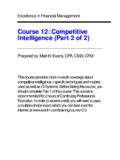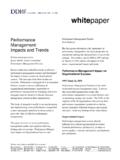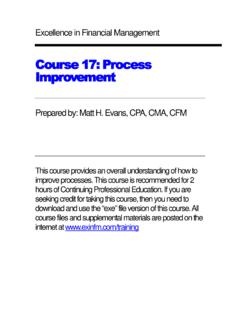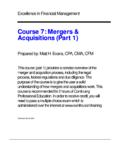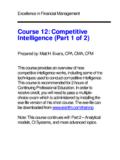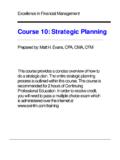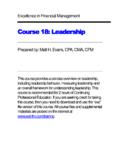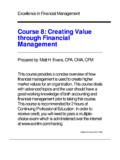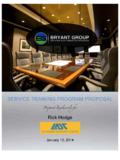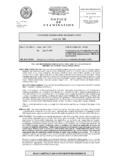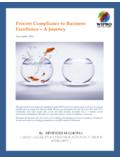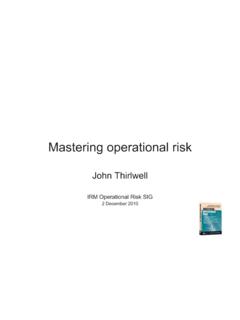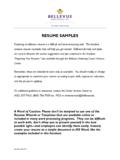Transcription of Mastering the Customer Experience: The Key …
1 Mastering the Customer experience : The Key Drivers for Success by IBF Management LLC. In today's environment a successful enterprise requires a clear and sustainable competitive advantage in the marketplace. A strategic differentiation can be gained by focusing on the single most important element of success the Customer . A business can ensure success by managing the Customer relationship and providing world-class Customer care, field support and billing services as efficiently as possible. Prior to exploring the factors that influence Customer service and the impact to the business, it is helpful to first appreciate the breadth of the design elements.
2 The illustration below details the facets of developing and executing a comprehensive strategy that is oriented around a common, clearly communicated vision and migration path. Business Architecture Business Architecture The target operating environment. Vision & Organization & Operating & Enabling Strategy Training Process Models Technologies Components Interrelated elements required to design and Customer implement the end - state. Employee Views Various, unique perspectives with each requiring definition Management within the architectural components. Organizational Operations Training Training Product Management Engineering Management Disciplines Required functional subject matter expertise Physical Communications & Process Functional Analysis Infrastructure Infrastructure Change Management Engineering Program Management Success is achieved through operational integration based on a structured alignment of disciplines across the enterprise.
3 The following describes the key drivers and approach for Mastering the Customer experience . Customer SERVICE DRIVERS. Several evolutionary drivers regardless of industry are having a profound impact on Customer service: strategic value of Customer care, an enterprise approach to Customer relationship management, operational innovation, technological advancements and Customer expectations. Strategic Value. The Customer service delivery model has a long, progressive history: administrative Customer support reactive Customer service proactive Customer care and, ultimately, Internet-based collaborative service.
4 The services business continues to strategically evolve: from a cost of doing business' that is vertically organized by narrowly defined segments of work/activities; to a multi-channel, cross-organizational approach that is horizontally aligned around Customer -focused processes. This strategic paradigm shift represents the recognition of Customer service management as a mission critical asset to the corporation for revenue-protection and revenue- generation opportunities. Increase Customer responsiveness and satisfaction Create Customer loyalty and increase retention Lower marketing and account acquisition costs Enhance corporate image and competitive advantage 2004 IBF Management, LLC Customer Relationship Management.
5 Enterprise-wide Customer relationship management has broadened the concept of Customer care no longer is it satisfactory to develop strategies and operations within organizational silos'. Personalized Customer contacts the basis for a business relationship require common Customer knowledge across internal functional areas. In addition, Customer segmentation rules based on contact triggers are necessary to reduce flight risk' of high-valued customers. An overall approach is required to synchronously manage across the traditional Customer -interfacing organizational boundaries, , marketing, sales, field service, technical and aftermarket support.
6 Understand Customer expectations and relationship management trends Create company-wide Customer management Establish learning relationships' with customers Operational Innovation. As corporations strategically leverage the Customer contact, innovation inherently follows. Leading-edge service organizations will look beyond the four walls of a particular operation and deliver Customer contacts to the most appropriate associate regardless of reporting structure applying the principles of the contact center across the enterprise. Thus, as benchmarks in providing exceptional service evolve, the continuous improvement paradigm becomes more of a necessity.
7 It is imperative, in the global competitive landscape, to not only benchmark within and across industries but strive to stay on the leading edge of providing world-class Customer care based on Customer needs and exceeding expectations. Provide service outside the traditional channels for 24x7x365. Set Customer service objectives that drive personalization adoption Create data- and knowledge-sharing infrastructure Learn from Customer data Realign compensation with Customer satisfaction and retention Technological Advancements. Technology applications are unique in both supporting and driving operational requirements consistently raising the bar' in how Customer and operations support are defined.
8 Advancements in both operation support systems and Customer -facing technolog ies promise flexibility and innovation. It is necessary to address human factors, business rules and workflow for a business to capitalize on these innovations. In addition, the Internet and other electronic communications raise unique challenges. For example, how to provide proactive, personalized service in an inherently impersonal environment where certain Customer touch points, such as email, are not real-time. Set the pace with personalized, proactive service Break down service silos to show one face to the Customer Coordinate across all Customer contact channels Customer Expectations.
9 Customers, too, are evolving: the expectations of Customer service transcend industries. Expectations have evolved to the point where exceptional Customer service is considered the minimal requirement and personalized, proactive Customer care is gaining momentum. Exceeding Customer expectations and providing solutions to both explicit Customer requests and implicit Customer needs are the primary objectives. Master Customer interactions on- and off-line for 24x7x365 availability Blending of sales and service paradigms An organization faces many challenges in achieving operational excellence and service delivery success.
10 Customer service must be synchronized across the business in order to master the Customer experience . A logical, phased approach that is Customer -focused, adapts to the changing environment, encourages continuous improvement and leverages the Customer contact personnel is advantageous to both the operation and Customer . 2004 IBF Management, LLC BRIDGING STRATEGY, PEOPLE, PROCESS & TECHNOLOGY. Success is based on viewing the Customer experience horizontally across the entire organization identifying at the functional level how each activity across the enterprise impacts the success of the organization and ultimately the Customer .

